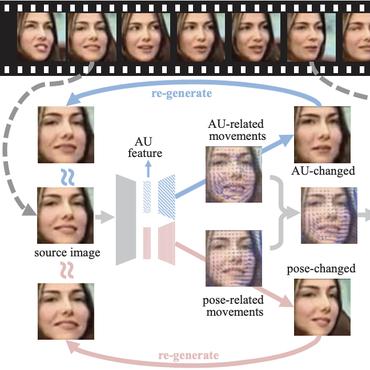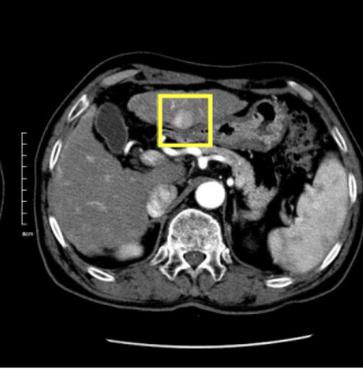Search Results for author: Hu Han
Found 29 papers, 13 papers with code
VIPL-HR: A Multi-modal Database for Pulse Estimation from Less-constrained Face Video
1 code implementation • 11 Oct 2018 • Xuesong Niu, Hu Han, Shiguang Shan, Xilin Chen
We also learn a deep HR estimator (named as RhythmNet) with the proposed spatial-temporal representation, which achieves promising results on both the public-domain and our VIPL-HR HR estimation databases.
3D U$^2$-Net: A 3D Universal U-Net for Multi-Domain Medical Image Segmentation
1 code implementation • 4 Sep 2019 • Chao Huang, Hu Han, Qingsong Yao, Shankuan Zhu, S. Kevin Zhou
Instead of a collection of multiple models, it is highly desirable to learn a universal data representation for different tasks, ideally a single model with the addition of a minimal number of parameters steered to each task.
Deep Learning to Segment Pelvic Bones: Large-scale CT Datasets and Baseline Models
1 code implementation • 16 Dec 2020 • Pengbo Liu, Hu Han, Yuanqi Du, Heqin Zhu, Yinhao Li, Feng Gu, Honghu Xiao, Jun Li, Chunpeng Zhao, Li Xiao, Xinbao Wu, S. Kevin Zhou
Due to the lack of a large-scale pelvic CT dataset with annotations, deep learning methods are not fully explored.
Video-based Remote Physiological Measurement via Cross-verified Feature Disentangling
1 code implementation • ECCV 2020 • Xuesong Niu, Zitong Yu, Hu Han, Xiaobai Li, Shiguang Shan, Guoying Zhao
Remote physiological measurements, e. g., remote photoplethysmography (rPPG) based heart rate (HR), heart rate variability (HRV) and respiration frequency (RF) measuring, are playing more and more important roles under the application scenarios where contact measurement is inconvenient or impossible.
Multi-label Co-regularization for Semi-supervised Facial Action Unit Recognition
1 code implementation • NeurIPS 2019 • Xuesong Niu, Hu Han, Shiguang Shan, Xilin Chen
In this work, we propose a semi-supervised approach for AU recognition utilizing a large number of web face images without AU labels and a relatively small face dataset with AU annotations inspired by the co-training methods.
FCSR-GAN: Joint Face Completion and Super-resolution via Multi-task Learning
1 code implementation • 4 Nov 2019 • Jiancheng Cai, Hu Han, Shiguang Shan, Xilin Chen
Combined variations containing low-resolution and occlusion often present in face images in the wild, e. g., under the scenario of video surveillance.
DISC: Learning From Noisy Labels via Dynamic Instance-Specific Selection and Correction
1 code implementation • CVPR 2023 • YiFan Li, Hu Han, Shiguang Shan, Xilin Chen
Then we propose a dynamic threshold strategy for each instance, based on the momentum of each instance's memorization strength in previous epochs to select and correct noisy labeled data.
Miss the Point: Targeted Adversarial Attack on Multiple Landmark Detection
1 code implementation • 10 Jul 2020 • Qingsong Yao, Zecheng He, Hu Han, S. Kevin Zhou
A comprehensive evaluation on a public dataset for cephalometric landmark detection demonstrates that the adversarial examples generated by ATI-FGSM break the CNN-based network more effectively and efficiently, compared with the original Iterative FGSM attack.
Encoding CT Anatomy Knowledge for Unpaired Chest X-ray Image Decomposition
1 code implementation • 16 Sep 2019 • Zeju Li, Han Li, Hu Han, Gonglei Shi, Jiannan Wang, S. Kevin Zhou
We hereby propose a decomposition generative adversarial network (DecGAN) to anatomically decompose a CXR image but with unpaired data.
Affective Behaviour Analysis Using Pretrained Model with Facial Priori
1 code implementation • 24 Jul 2022 • YiFan Li, Haomiao Sun, Zhaori Liu, Hu Han
As a result, we utilize AffectNet pretrained CNN to extract expression scores concatenating with expression and AU scores from ViT to obtain the final VA features.
Data-Free Knowledge Distillation via Feature Exchange and Activation Region Constraint
1 code implementation • CVPR 2023 • Shikang Yu, Jiachen Chen, Hu Han, Shuqiang Jiang
Therefore, we propose mSARC to assure the student network can imitate not only the logit output but also the spatial activation region of the teacher network in order to alleviate the influence of unwanted noises in diverse synthetic images on distillation learning.
Decoupled Textual Embeddings for Customized Image Generation
1 code implementation • 19 Dec 2023 • Yufei Cai, Yuxiang Wei, Zhilong Ji, Jinfeng Bai, Hu Han, WangMeng Zuo
To decouple irrelevant attributes (i. e., background and pose) from the subject embedding, we further present several attribute mappers that encode each image as several image-specific subject-unrelated embeddings.
Modeling the Relative Visual Tempo for Self-supervised Skeleton-based Action Recognition
1 code implementation • ICCV 2023 • Yisheng Zhu, Hu Han, Zhengtao Yu, Guangcan Liu
Specifically, we design a Relative Visual Tempo Learning (RVTL) task to explore the motion information in intra-video clips, and an Appearance-Consistency (AC) task to learn appearance information simultaneously, resulting in more representative spatiotemporal features.
Heterogeneous Face Attribute Estimation: A Deep Multi-Task Learning Approach
no code implementations • 3 Jun 2017 • Hu Han, Anil K. Jain, Fang Wang, Shiguang Shan, Xilin Chen
In DMTL, we tackle attribute correlation and heterogeneity with convolutional neural networks (CNNs) consisting of shared feature learning for all the attributes, and category-specific feature learning for heterogeneous attributes.
 Ranked #5 on
Facial Attribute Classification
on LFWA
Ranked #5 on
Facial Attribute Classification
on LFWA
Tattoo Image Search at Scale: Joint Detection and Compact Representation Learning
no code implementations • 1 Nov 2018 • Hu Han, Jie Li, Anil K. Jain, Shiguang Shan, Xilin Chen
To close the gap, we propose an efficient tattoo search approach that is able to learn tattoo detection and compact representation jointly in a single convolutional neural network (CNN) via multi-task learning.
Mean-Variance Loss for Deep Age Estimation From a Face
no code implementations • CVPR 2018 • Hongyu Pan, Hu Han, Shiguang Shan, Xilin Chen
Age estimation has broad application prospects of many fields, such as video surveillance, social networking, and human-computer interaction.
 Ranked #3 on
Age Estimation
on ChaLearn 2016
Ranked #3 on
Age Estimation
on ChaLearn 2016
RhythmNet: End-to-end Heart Rate Estimation from Face via Spatial-temporal Representation
no code implementations • 25 Oct 2019 • Xuesong Niu, Shiguang Shan, Hu Han, Xilin Chen
Recently, some methods have been proposed for remote HR estimation from face videos; however, most of them focus on well-controlled scenarios, their generalization ability into less-constrained scenarios (e. g., with head movement, and bad illumination) are not known.
The 1st Challenge on Remote Physiological Signal Sensing (RePSS)
no code implementations • 26 Mar 2020 • Xiaobai Li, Hu Han, Hao Lu, Xuesong Niu, Zitong Yu, Antitza Dantcheva, Guoying Zhao, Shiguang Shan
Remote measurement of physiological signals from videos is an emerging topic.
Cross-domain Face Presentation Attack Detection via Multi-domain Disentangled Representation Learning
no code implementations • CVPR 2020 • Guoqing Wang, Hu Han, Shiguang Shan, Xilin Chen
In light of this, we propose an efficient disentangled representation learning for cross-domain face PAD.
Human Recognition Using Face in Computed Tomography
no code implementations • 28 May 2020 • Jiuwen Zhu, Hu Han, S. Kevin Zhou
With the mushrooming use of computed tomography (CT) images in clinical decision making, management of CT data becomes increasingly difficult.
Bounding Maps for Universal Lesion Detection
no code implementations • 18 Jul 2020 • Han Li, Hu Han, S. Kevin Zhou
The bounding maps (BMs) are used in two-stage anchor-based ULD frameworks to reduce the FP rate.
Conditional Training with Bounding Map for Universal Lesion Detection
no code implementations • 23 Mar 2021 • Han Li, Long Chen, Hu Han, S. Kevin Zhou
Universal Lesion Detection (ULD) in computed tomography plays an essential role in computer-aided diagnosis.
 Ranked #3 on
Medical Object Detection
on DeepLesion
Ranked #3 on
Medical Object Detection
on DeepLesion
Where is the disease? Semi-supervised pseudo-normality synthesis from an abnormal image
no code implementations • 24 Jun 2021 • Yuanqi Du, Quan Quan, Hu Han, S. Kevin Zhou
Pseudo-normality synthesis, which computationally generates a pseudo-normal image from an abnormal one (e. g., with lesions), is critical in many perspectives, from lesion detection, data augmentation to clinical surgery suggestion.
Dual-GAN: Joint BVP and Noise Modeling for Remote Physiological Measurement
no code implementations • CVPR 2021 • Hao Lu, Hu Han, S. Kevin Zhou
Remote photoplethysmography (rPPG) based physiological measurement has great application values in health monitoring, emotion analysis, etc.
Automatic Facial Paralysis Estimation with Facial Action Units
no code implementations • 3 Mar 2022 • Xuri Ge, Joemon M. Jose, Pengcheng Wang, Arunachalam Iyer, Xiao Liu, Hu Han
In this paper, we propose a novel Adaptive Local-Global Relational Network (ALGRNet) for facial AU detection and use it to classify facial paralysis severity.
SATr: Slice Attention with Transformer for Universal Lesion Detection
no code implementations • 13 Mar 2022 • Han Li, Long Chen, Hu Han, S. Kevin Zhou
Universal Lesion Detection (ULD) in computed tomography plays an essential role in computer-aided diagnosis.
MGRR-Net: Multi-level Graph Relational Reasoning Network for Facial Action Units Detection
no code implementations • 4 Apr 2022 • Xuri Ge, Joemon M. Jose, Songpei Xu, Xiao Liu, Hu Han
While the region-level feature learning from local face patches features via graph neural network can encode the correlation across different AUs, the pixel-wise and channel-wise feature learning via graph attention network can enhance the discrimination ability of AU features from global face features.
Mixed-order self-paced curriculum learning for universal lesion detection
no code implementations • 9 Feb 2023 • Han Li, Hu Han, S. Kevin Zhou
Most SCL methods commonly adopt a loss-based strategy of estimating data difficulty and deweighting the `hard' samples in the early training stage.
AgeNet: Deeply Learned Regressor and Classifier for Robust Apparent Age Estimation
no code implementations • ICCV Workshop 2015 • Xin Liu, Shaoxin Li, Meina Kan, Jie Zhang, Shuzhe Wu, Wenxian Liu, Hu Han, Shiguang Shan, Xilin Chen
Another key feature of the proposed AgeNet is that, to avoid the problem of over-fitting on small apparent age training set, we exploit a general-to-specific transfer learning scheme.
 Ranked #4 on
Age Estimation
on ChaLearn 2015
Ranked #4 on
Age Estimation
on ChaLearn 2015


















